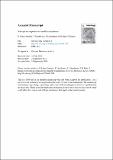| dc.contributor.author | Upadhyaya, P. | |
| dc.contributor.author | Liljenhjerte, J. | |
| dc.contributor.author | Kumar, S. | |
| dc.contributor.author | Lopez Jimenez, Francisco | |
| dc.contributor.author | Reis, Pedro Miguel | |
| dc.date.accessioned | 2018-07-25T18:03:57Z | |
| dc.date.available | 2018-07-25T18:03:57Z | |
| dc.date.issued | 2016-09 | |
| dc.date.submitted | 2016-09 | |
| dc.identifier.issn | 2352-4316 | |
| dc.identifier.uri | http://hdl.handle.net/1721.1/117121 | |
| dc.description.abstract | We introduce a soft composite that is actuated mechanically to achieve switchable and tunable optical transmittance. Our design comprises a series of parallel opaque platelets embedded into an optically clear silicone-based elastomer matrix. Under an applied shear loading, the platelets rotate, thereby gradually increasing the transmittance of light through the device, in a controllable and reversible manner. Experiments on a prototype device are used to support finite element simulations that explore the parameter space of the system towards providing a set of design guidelines. Specifically, we study how the optical transmittance depends on the stiffness mismatch between the matrix and the platelets, as well as their initial orientation and aspect ratio. We also focus on the maximum attainable value of transmittance and the energetic requirements to achieve it. Keywords: Soft materials; Composites; Transmittance; Optical devices | en_US |
| dc.description.sponsorship | National Science Foundation (U.S.) (Grant CMMI-1351449) | en_US |
| dc.publisher | Elsevier | en_US |
| dc.relation.isversionof | http://dx.doi.org/10.1016/J.EML.2016.09.003 | en_US |
| dc.rights | Creative Commons Attribution-NonCommercial-NoDerivs License | en_US |
| dc.rights.uri | http://creativecommons.org/licenses/by-nc-nd/4.0/ | en_US |
| dc.source | Other univ. web domain | en_US |
| dc.title | Soft optical composites for tunable transmittance | en_US |
| dc.type | Article | en_US |
| dc.identifier.citation | López Jiménez, F. et al. “Soft Optical Composites for Tunable Transmittance.” Extreme Mechanics Letters 9 (December 2016): 297–303 © 2016 Elsevier Ltd | en_US |
| dc.contributor.department | Massachusetts Institute of Technology. Department of Civil and Environmental Engineering | en_US |
| dc.contributor.department | Massachusetts Institute of Technology. Department of Mechanical Engineering | en_US |
| dc.contributor.mitauthor | Lopez Jimenez, Francisco | |
| dc.contributor.mitauthor | Reis, Pedro Miguel | |
| dc.relation.journal | Extreme Mechanics Letters | en_US |
| dc.eprint.version | Author's final manuscript | en_US |
| dc.type.uri | http://purl.org/eprint/type/JournalArticle | en_US |
| eprint.status | http://purl.org/eprint/status/PeerReviewed | en_US |
| dc.date.updated | 2018-07-18T17:20:09Z | |
| dspace.orderedauthors | López Jiménez, F.; Upadhyaya, P.; Liljenhjerte, J.; Reis, P.M.; Kumar, S. | en_US |
| dspace.embargo.terms | N | en_US |
| dc.identifier.orcid | https://orcid.org/0000-0001-8569-5400 | |
| dc.identifier.orcid | https://orcid.org/0000-0003-3984-828X | |
| mit.license | PUBLISHER_CC | en_US |
